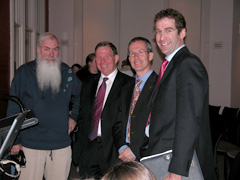
Pressed plants: key to Australia's future

Collections of pressed plants, stuffed birds and pinned insects are a vast and rich resource whose full potential is yet to be realised, according to Dr Tim Entwisle, Executive Director of the Botanic Gardens Trust, Sydney.
Speaking at the opening of the Natura Morta exhibition in Sydney for National Science Week, Dr Entwisle described Australia’s biological collection totalling 50 million samples - each of them unique - as “a priceless asset”.
The exhibition comprises artwork by scientific illustrators EH Zeck and Margaret Senior, which is owned by the NSW Agricultural Scientific Collections Trust (ASCT).
Dr Entwisle, who is also a member of the ASCT, said most auditors either give biological collections arbitrary values based on “dubious assumptions” or say they have no reliable value.
He says biological collections are of immense worth to scientists, farmers, bush regenerators – “anyone making decisions about our living environment”.
“They can’t be re-collected – and they include more than two centuries of scientific knowledge about the half million or so species that live in Australia.”
He said museums and herbaria had responded to community needs for better information on Australia’s living resources through initiatives such as the development of ‘virtual’ collections to “maximise the return from this priceless investment”.
This involved recording collections in databases and linking them through the internet, such that “the whole is greater than the sum of the parts”.
He said websites such as “Australia’s Virtual Herbarium” at
http://plantnet.rbgsyd.nsw.gov.au/avh.html
brought data from each State together, creating an online library.
“The Department of Primary Industries might for instance want to know what new plants are recorded from NSW so they can assess their weed potential. The Botanic Gardens can now let them know as soon as a plant is located, before it spreads too far and becomes invasive.”
Dr Entwisle said the value of the ‘virtual’ collection plummets if actual specimens do not exist for each record: “The specimens are your scientific evidence.”
He said the internet had also made it possible for plants to be identified online.
“There are networks, for instance in the United States and in Australia’s CSIRO, where a specimen can be viewed through a video camera and then identified by experts some distance away.”
Other developments sprang from the DNA revolution, such as DNA “blasting” in which patterns of DNA were compared.
These could make it easier and faster to identify species; however, they would not always pick up variability between species.
Dr Entwisle said the discovery of the Wollemi Pine showed that there are still major gaps in our knowledge.
“The Wollemi Pine is from a lineage of organisms where there are no close relatives still alive today. It is this that makes it important, not just its rarity.
“Good systematics – being able to accurately classify species – depends on having physical specimens in a collection”, he said.
Email:

